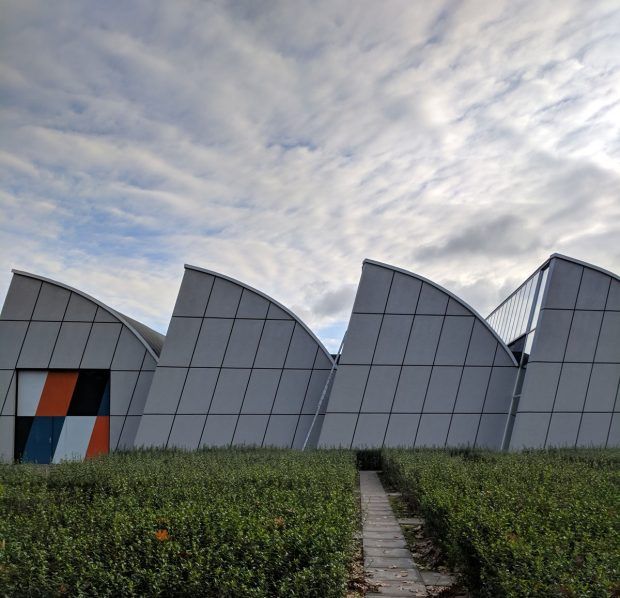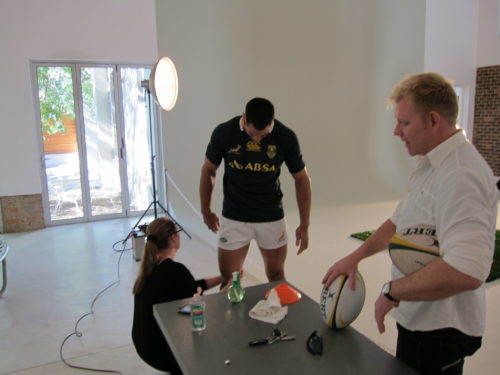My morning started with a bus ride from the Eindhoven city center to a small town on my way for a tour of Bergeijk, specifically the iconic De Ploeg building. A collaboration between two Dutch artists from the De Stijl period, De Ploeg was once a weaving mill where they made curtains in the 1970’s (you can imagine the style).

Bergeijk and its History
The building was designed by Gerrit Rietveld (famous for his De Stijl chair) and Mien Ruys. De Stijl is one of those artistic movements that triggers something in each of us. Largely made up of simple lines and primary colors, it’s the type of art that people have an immediate reaction to. Throughout my childhood I had a poster of one of Piet Mondrian’s works hanging in my bedroom so I grew up with the clean aesthetic of De Stijl; it’s partly what inspired my love of design.
De Stijl takes the abstraction from earlier periods of art and brings it to an extreme. Color and form are portrayed seemingly simplistically in a rigid structure. While the forms follow basic principles (straight lines, squares, rectangles and primary colors), those are abstracted further with asymmetrical designs.
Architecturally, Rietveld took these principles and applied them to his buildings and furniture designs. Walking through the complex on a brisk October morning, it’s easy to see how design can have an effect. My guided tour led me through the main building, but also to a home on the property. Low ceilings in the home but with big windows, a strict geometrical layout and bedrooms with walls that can be moved and adjusted with ease—this is the ultimate style of practicality. Where form can change and adapt depending upon the building’s needs and uses.
Gerrit Rietveld is most famous for the Schröder House (a UNESCO World Heritage Site) located in Utrecht, a private home designed with as few walls as possible. It looks like a puzzle from the outside. As one of the most iconic designers part of the Dutch De Stijl movement, Rietveld also designed furniture, including the Red and Blue Chair—again, the primary colors and a design made of rigid lines.

His work at the De Ploeg factory in Bergeijk was different in the fact that he was designing a large industrial building and complex. He worked with Mien Ruys, the Netherlands’ first landscape architect. She was responsible for designing the park that serves as the main entrance to the De Ploeg building in Bergeijk. A large clock, in the typical De Stijl fashion, stands at the street entrance to the Bergeijk complex —a utilitarian tool for the workers showing up at the factory every day.

Rietveld’s design for De Ploeg allowed for the most optimal amount of open space and light. Large windows connected the indoor and outdoor spaces to make it seem as if those working indoors were actually outdoors.
Bergeijk: as a factory, it was set in the back of a large park with imported trees and a sweeping landscape. The building itself was designed to let in as much natural light as possible, hence the curved roofs facing the sun. The factory was actually in operation up until 2007 until the building was abandoned, and only recently renovated. Today it’s a working office and factory for a new business, but it’s still possible to visit. A small visitors center arranges tours and exhibitions.

Design serves a number of purposes, and at the Rietveld factory in Bergeijk, it’s easy to see how design was once perceived—an abstract connection to the natural world. De Stijl design might look simple and straightforward to the outsider (I could draw that), but its ability to recreate and accentuate nature through physical objects makes it timeless.
Visit Rietveld’s iconic building on a walking tour available upon reservation. The visitors center is open weekdays from 10am to 4pm. It’s easy to reach the building via public transport (a quick 30-minute bus from Eindhoven) or car.











Discover more off-beat destinations in the Brabant region of Holland from the official tourism website.
• • •
The year 2017 marks 100 years since De Stijl, the Dutch art movement, was founded. Countless inspiring events and exhibitions will be held throughout Holland in 2017 to celebrate this feat. De Stijl started in Leiden in 1917 when De Stijl magazine was established by Theo van Doesburg. Read more about the art movement and the Dutch year of design on visitholland.com, From Mondriaan to Dutch Design.

In 2009, Adam Groffman quit his job as a graphic designer in Boston and went on a 15+ month trip around the world. The life-changing journey took him to places like North Africa, the Middle East, India and Southeast Asia. Since 2011 Adam has been living in Berlin—Europe’s most hipster city.
Travels of Adam is a hipster travel & lifestyle blog for sharing his personal experiences and alternative & indie travel tips from around the world. He also is the editor of My Gay Travel Guide—a gay travel website written by gay travelers for gay travelers.








